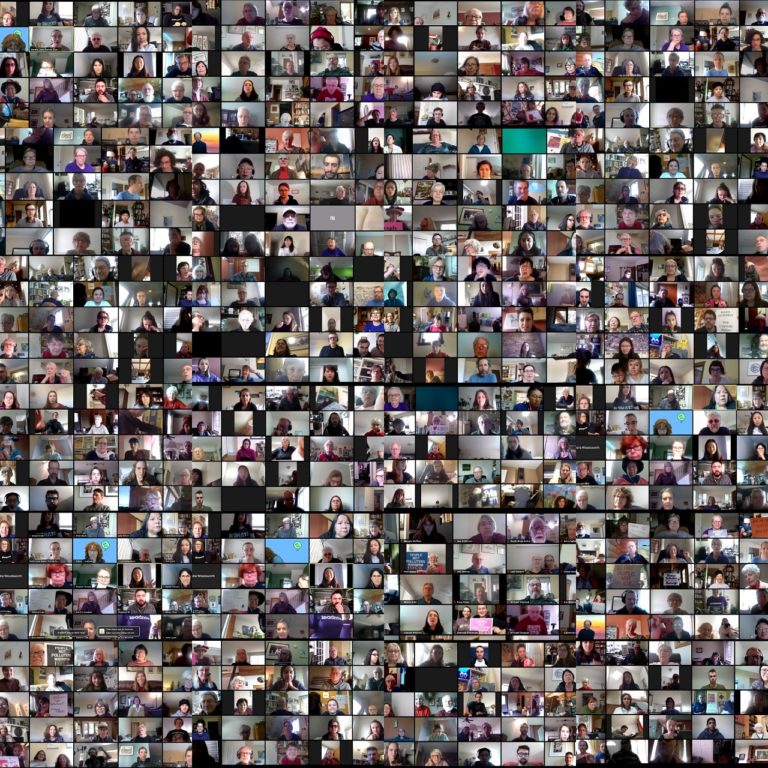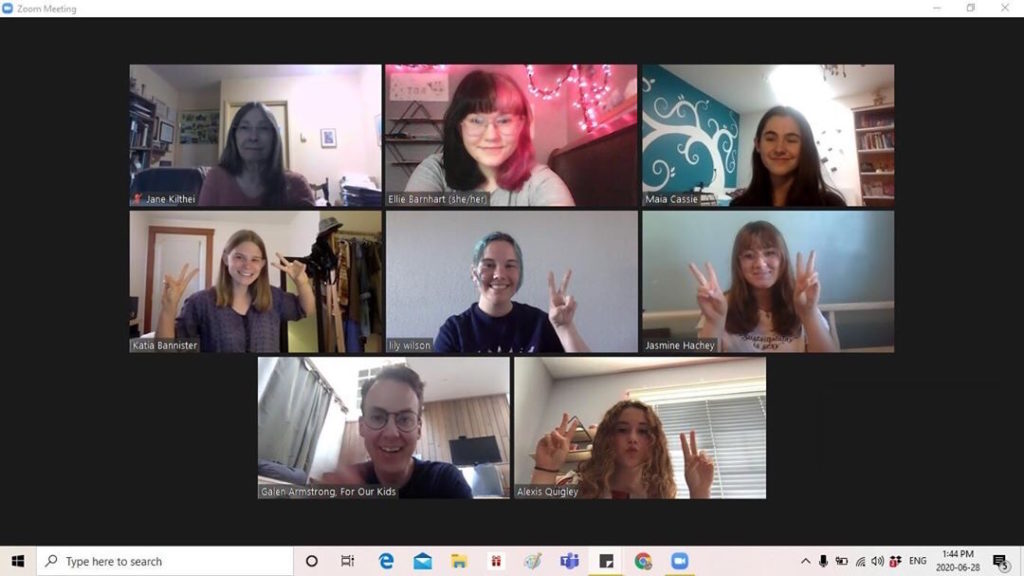Climate activism in the COVID-19 pandemic
Youth took to the streets in March 2019 to demand climate action. One year later, their activism looks very different.
My name is Katia Bannister. I am a seventeen year-old youth climate activist, Vote16BC campaigner and community organizer in the Cowichan Valley on Vancouver Island.
After months of reading about it online and hearing about it on TV, the coronavirus pandemic emerged fully in our province in March. Right around the time it did, I had been celebrating the anniversary of my first official year as a youth climate activist and climate striker.
Over the past year my life had changed completely. The experiences I’ve had, the people I’ve met and the things I’ve learned are all unparalleled. I’ve felt this global, youth-led movement grow and evolve, become more inclusive, facilitate more learning and action, and reach more people.
The months leading up to March 2020 felt like only the beginning. I was looking forward to attending and hosting even more climate strikes, spending time building relationships between individuals and organizations in my community, encouraging other youth to feel empowered through their skills and passions, and with them, creating action.
COVID-19 and climate action
And then came March, the beginning of the COVID-19 pandemic in B.C. The plans I had set into motion with my organizing group ground to a halt. At first we thought the pandemic-triggered standstill would be temporary. We asked ourselves, “How long could this possibly last?” But the answer eventually became clear. Things were not going back to normal and life was not going to be the same.
I had only started considering myself a youth climate activist a year before the pandemic hit. I was still very new to organizing and mobilizing, team-building, creating community resiliency and facilitating diverse groups. Many other youth climate activists were in exactly the same boat.
March 15, 2019 was the first ever global day for climate action, when youth around the world took up the first global climate strike. A huge percentage of the youth who are now at the forefront of the global, youth-led climate justice movement began taking action on that day. Since then, we’ve faced – and overcome – all kinds of challenges, from learning how to get permits for events to creating organizations that have opportunity for the multi-level engagement of diverse people. We’ve been learning everyday, every step of the way. So in a way, we were ready for COVID-19.
When COVID-19 hit, unbeholden to familiar ways of organizing and with experience in the digital world, youth climate activists quickly shifted their engagement strategy – restructuring their organizing groups and thinking of creative and COVID-friendly ways that they could use to continue to make change.
In Canada, many youth climate activists had been preparing through February and March for a National Day of Climate Action on April 3. When youth organizing groups faced the realization that large public get-togethers would not be a possibility – nor would they be a responsible course of action – they moved these events online.

Some of the 920 attendees of Canada’s first online climate rally, April 3 2020.
Some groups, like the Sustainabiliteens in Vancouver, hosted digital rallies instead of in-person ones. The digital rally hosted by Sustainabiliteens was attended by almost 1,000 people, with thousands more viewing a livestream on Dogwood’s Facebook page. Rallies like these would evolve into a huge global digital-strike movement throughout the pandemic.
Another recurring “event” that began on April 3 is the Fridays For Future Digital Strike Movement. Established in 2019, the strikes took off when youth could no longer storm the streets for climate action because of COVID-19. The movement originally was meant to give students who couldn’t skip school a way to climate strike – whether because of harsh school policy or parents who didn’t support striking – and to show their solidarity with the youth climate strike movement. Youth (and older supporters too) can post pictures of themselves holding climate strike signs on Facebook, Instagram or Twitter to show their solidarity and take action from home. These digital strikes have become increasingly popular since the emergence of COVID and are yet another demonstration of the creativity and resiliency of youth climate activists.

Katia Bannister participates in the “Fridays for Future” digital strike.
How has climate activism grown in the pandemic?
When the coronavirus pandemic first started making headlines around the world and created restrictions on the actions that youth climate activists could take, I asked myself: “How do we as youth climate activists not only hold on to the momentum our movement has gained over the past year, but also continue to let our movement grow? Even through these times of isolation and uncertainty?”
I know many other teenage organizers posed similar questions to themselves. So much work by devoted youth had been put into building the movement we were all a part of, and we knew it couldn’t end there.
We are determined not to be snuffed out by government and dwindling public attention due to the pandemic. Climate change remains a threat, despite being ignored by decision-makers. The time for climate action remains now – climate change can’t fall out of the spotlight.
So, we remain locked in a struggle for climate justice – whatever shape it takes – and with whatever tools we have available to us. But as youth, we can be disadvantaged because of our age, which limits the rights that are afforded to us. Youth under 18 years old can’t vote. At least not yet. We know this gives us less leverage with elected lawmakers. But we do have a solid foundation of organizing, digital savviness and passion to create a better future. We are still here, demanding real climate action.
Taking action together
The continued change made and awareness raised over the past few months is owed largely to collaborative work done by dedicated youth climate activists and supported by allies of many ages. Coming together to support each other through difficult times and turmoil is essential in the context of COVID-19. And it is not unlike the community of support and action we must build to tackle the climate crisis.
The immediacy so many have felt about substantial action to prevent the unchecked spread of COVID-19 is similar to what so many youth feel about the climate crisis. Swift action must be taken, and shifts to our mindsets, as well as changes to our lifestyles, must be made.
I like to say that effective change is “locally grown and globally sown.” It will take all of us becoming aware of what is happening in our communities and in the world, and evaluating our personal responsibilities while shifting the perceived blame for climate change from the hands of individuals – as corporations would have us believe – to the real impetus: lining the pockets of those corporations. Then we will take our experiences with activism and COVID-19 and turn them into lessons for mobilizing and organizing for climate action.
Government action on climate change was already weak before the coronavirus pandemic and in many aspects, non-existent since COVID-19 hit. Redirection of resources and political attention during the pandemic is in some cases understandable. However, the harsh reality facing us is that without a planet that is hospitable to life, a pandemic becomes a secondary issue. We can’t ignore the climate crisis. Ultimately, we will need to find a way to coexist with COVID-19 but we will not be able to find ways to exist alongside the irreversible ecological damage that climate change will cause.
COVID-19 has already given our society and our governments a blueprint for taking effective action quickly. Just like the virus, the climate emergency is a threat to humanity. But unlike COVID, it will not only affect human communities, but ecological communities, ecosystems and the entire biosphere.
The pandemic has demonstrated that we can come together as activists, change makers and people who care – regardless of the knowledge or experience we possess – to take tangible action. Together.


Whoohooo… way to be Katia ♥️🥳 this is amazing and I Wished I knew of this Sooner.. I guess I just wanted to say good job and wishing you all the best in future work. 🔥🥳